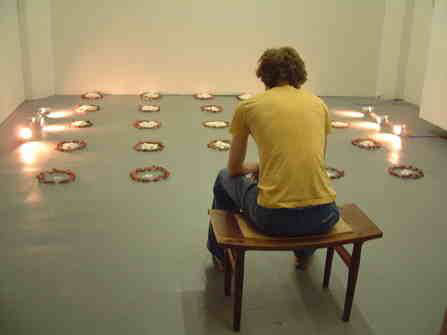STATEMENT
na wai keia ike o ka lani? (for whom this view of heaven?) 2004 Installation, UMBC/Raleigh Graduate MFA Studios, Baltimore, MD. A time- and process-based installation that took place over 30 days. This work addressed tourism and it's impact on Hawai‘i residents. Materials consisted of imported, "cheap" hotel sized soap bars, hand-strung Hawaiian orchard leis created from Moloka‘i orchids, lights, bench, 4-track original sound score of dripping water.
Nothing I produce within my lifetime is likely to change the course of history; this is a fact of which I am all too keenly aware. Despite this, I believe the most important thing is to act as if I can.
na wai ka ‘ike o ka lani? (to whom does this view of heaven belong?) is informed by concerns borne within the community of my Hawai’i home, where I have lived for the past 10 years. During that time, I have married a ‘local’ man, conceived a hapa (part- Hawaiian) child, and hence, have built my life there. A natural outgrowth of existing in such a distant and minute society is my consternation about asset consumption within islands that have economies governed by the visitor-industry.
Dwindling natural resources, on the one hand, and the magnitude of infrastructure required to expand this industry, on the other, stand in direct opposition to each other. In Hawai’i, our government’s stated goal of attracting an ever-increasing number of dailyarrivalsionlyexacerbatesthehardshipsour‘aina(land)andourmaka’ainana(‘childrenoftheland’)mustendure. Aswith many other islands dominated by a tourist-economy, ideals for Hawai’i tourism are transplanted from the colonial plantation mentality of the past century. Dependence upon it as the major source of income enslaves residents to menial service jobs paying humble wages; it further mandates that they house large extended families within small rented homes. I do not want my half-Hawaiian son to grow up to believe that these are the decisive values upon which to build his life.
In an essay concerning political art entitled Spies and Watchmen, artist Thomas Lawson writes, “An art of representation, a flirtation with misrepresentation. An ambiguous art that seems to flatter the situation it supports while undermining it. Sweetly arbitrary, art which appears attractively irrational, but it turns out to be coldly rational; art which looks distant, but is deeply felt.” na wai ka ‘ike o ka lani? situates itself within these ideals and, through its specious beauty, seeks to create discourse about the tourism industry’s utilization of island-based capital.
Materials have a mana (power) and a life that exists due to their uses in the ‘real’ world. The objects I have chosen–1/2-ounce bars of ‘hotel’ soap and tourist leis (flower necklaces)–each have a ‘real world’ role to fulfill. I have selected these specifically for their meaning vis-a-vis Hawaiian tourism and water usage patterns on O’ahu. Yet I have chosen to subvert their more palpable characteristics in order to make them appurtenances of my own command. As this work speaks to issues that will continue to evolve over the next 16 years, the passage of time serves as a fundamental and critical element, but one that cannot be displayed during the course of the few hours in which you are able to view this work. In its ideal presentationii, na wai ka ‘ike o ka lani? would exist over the course of 30 days. During this time, the leis would transform from luxuriant fresh blossoms to dried facsimiles of their former splendor. These leis (which I fabricated) consist of orchids ordered from a small O’ahu grower; the soaps were purchased from an internet-based wholesale supplier. The sources of these materials speak volumes more than my words ever might. I find it impossible to separate the materials and their sources from larger meanings pertaining to globalization, capitalism and colonial historyiii. Additionally, the incredible extent of toil in creating the leis and arranging the installation is equally important, though little is the ultimate reward for my effort, however undermining to the system its intent may be.
Yet, I continue to act as if I can. For it is only through hope–for sustainable change in our planet’s usage of ecological and human capital; for the ability of one person to actually make a difference; for a better future for my five year-old son–that I continue to believe my work might have relevance to anyone other than me.
return to Immersive Installations


